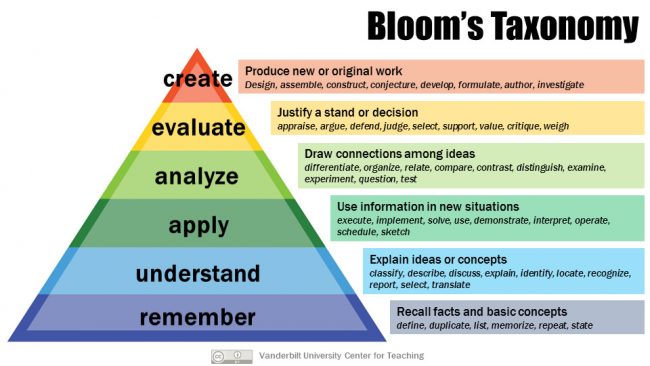verb
1. Apply oneself or dedicate one's energies to bringing something into existence.
2. Intentionally preparing and acting towards birthing, raising, and/or growing new ideas, art forms, ways of being.
Creation is the highest form of cognitive, affective, and sensorial ability of a human being. In Bloom's Taxonomy (1) Benjamin Bloom and his colleagues originally had "Evaluate" as the highest order of thinking. However, "Create" has since risen to the highest ranking of our ability to think and reason. "Create" is defined as "produce new or original work" which includes design, assemble, construct, conjecture, formulate, author, investigate.
As an educator and firm believer that we learn best through experience and doing, its seems to me that "create" is indeed the highest form of thinking and being in which we could possibly engage. Having been in the classroom and an instructional specialist for over 15 years now, I often find myself wondering what would happen if every school was a design school. Not only at the high school or middle school level, but what if the United States of America decided to engage its youth in radical creating from a very young age within the public school setting?
What I am proposing is nothing new, there are countless programs, program evaluations, and research showing that children who engage in play and creative play from a very young age develop a stronger sense of self and often fare better in the academic realm in general. However, a lot of these programs are not public and if they are it is rare that they are embedded in public preschools and elementary schools across a range of communities of all social economic levels.
What I am proposing is nothing new, there are countless programs, program evaluations, and research showing that children who engage in play and creative play from a very young age develop a stronger sense of self and often fare better in the academic realm in general. However, a lot of these programs are not public and if they are it is rare that they are embedded in public preschools and elementary schools across a range of communities of all social economic levels.
What I do know from my years teaching, learning, and coaching students (young and adult alike) is that at our core we long to be seen and feel like we matter so that we can exert positive influence within our community (school, classroom, neighborhood, etc). At our core, we want to know that we are seen for who we are and that we belong within the spaces where we live and learn. When we do not feel seen or like we matter, we often exert negative influence within our spaces and rupture the bridges extended to us by well-meaning albeit single-serving community members who are not able to see us or create spaces where we matter.
This core concept of community building is at the core of my classroom community and relationship with my teachers. I realized this morning that this way of being originating from Responsive Classroom and Tribes is in and of itself a creation of spaces where people can then create positive actions which in turn allows them to exert positive influence within the classroom community. This link between community building strategies and education as a means of creation invites us to rethink school structures and curriculum.
Our schools are complex systems and capable of housing authentic growth mindset spaces. Many teachers and administrators already support such structures. These spaces often look like studios where students are in charge of their bodies and learning. This is not to say that some do not struggle to focus nor do these spaces come without challenges. However, these spaces embody the growth mindset and flexible thinking that we want of all learners in this day and age. These spaces allow for neurodiversity to exist and thrive.
My musing today is to ponder the following: what would happen if the content that we were delivering to students was done in a way in which the end result was to demonstrate mastery through creating something? What would standards of education and proof of mastery look like in an education system that valued the growth mindset with creation at its highest rank? How can we cultivate more creation in our public schools and learning spaces?
Happy creativating!
My musing today is to ponder the following: what would happen if the content that we were delivering to students was done in a way in which the end result was to demonstrate mastery through creating something? What would standards of education and proof of mastery look like in an education system that valued the growth mindset with creation at its highest rank? How can we cultivate more creation in our public schools and learning spaces?
Happy creativating!
(1) Vanderbilt University Center for Teaching

No comments:
Post a Comment